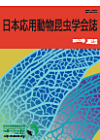Volume 57, Issue 3
Displaying 1-18 of 18 articles from this issue
- |<
- <
- 1
- >
- >|
Review: Regional Topics on Pest Control Research in Japan
-
Article type: Review
2013Volume 57Issue 3 Pages 129-135
Published: August 25, 2013
Released on J-STAGE: November 07, 2013
Download PDF (2993K) -
Article type: Review
2013Volume 57Issue 3 Pages 137-149
Published: August 25, 2013
Released on J-STAGE: November 07, 2013
Download PDF (1018K)
Original Articles
-
Article type: Original Article
2013Volume 57Issue 3 Pages 151-157
Published: August 25, 2013
Released on J-STAGE: November 07, 2013
Download PDF (1515K) -
Article type: Original Article
2013Volume 57Issue 3 Pages 159-166
Published: August 25, 2013
Released on J-STAGE: November 07, 2013
Download PDF (1403K) -
Article type: Original Article
2013Volume 57Issue 3 Pages 167-175
Published: August 25, 2013
Released on J-STAGE: November 07, 2013
Download PDF (1004K) -
Article type: Original Article
2013Volume 57Issue 3 Pages 177-183
Published: August 25, 2013
Released on J-STAGE: November 07, 2013
Download PDF (834K)
Short Communications
-
Article type: Short Communication
2013Volume 57Issue 3 Pages 185-189
Published: August 25, 2013
Released on J-STAGE: November 07, 2013
Download PDF (9782K) -
Article type: Short Communication
2013Volume 57Issue 3 Pages 189-191
Published: August 25, 2013
Released on J-STAGE: November 07, 2013
Download PDF (472K)
Technical Note
-
Article type: Technical Note
2013Volume 57Issue 3 Pages 192-194
Published: August 25, 2013
Released on J-STAGE: November 07, 2013
Download PDF (364K)
-
2013Volume 57Issue 3 Pages 195-196
Published: August 25, 2013
Released on J-STAGE: November 07, 2013
Download PDF (305K) -
2013Volume 57Issue 3 Pages 197-206
Published: August 25, 2013
Released on J-STAGE: November 07, 2013
Download PDF (2134K) -
2013Volume 57Issue 3 Pages 207-209
Published: August 25, 2013
Released on J-STAGE: November 07, 2013
Download PDF (381K) -
2013Volume 57Issue 3 Pages 210-216
Published: August 25, 2013
Released on J-STAGE: November 07, 2013
Download PDF (157K) -
2013Volume 57Issue 3 Pages 217-218
Published: August 25, 2013
Released on J-STAGE: November 07, 2013
Download PDF (150K) -
2013Volume 57Issue 3 Pages H31-
Published: August 25, 2013
Released on J-STAGE: November 07, 2013
Download PDF (117K) -
2013Volume 57Issue 3 Pages H32-
Published: August 25, 2013
Released on J-STAGE: November 07, 2013
Download PDF (211K) -
2013Volume 57Issue 3 Pages H33-
Published: August 25, 2013
Released on J-STAGE: November 07, 2013
Download PDF (186K) -
2013Volume 57Issue 3 Pages H34-
Published: August 25, 2013
Released on J-STAGE: November 07, 2013
Download PDF (82K)
- |<
- <
- 1
- >
- >|
